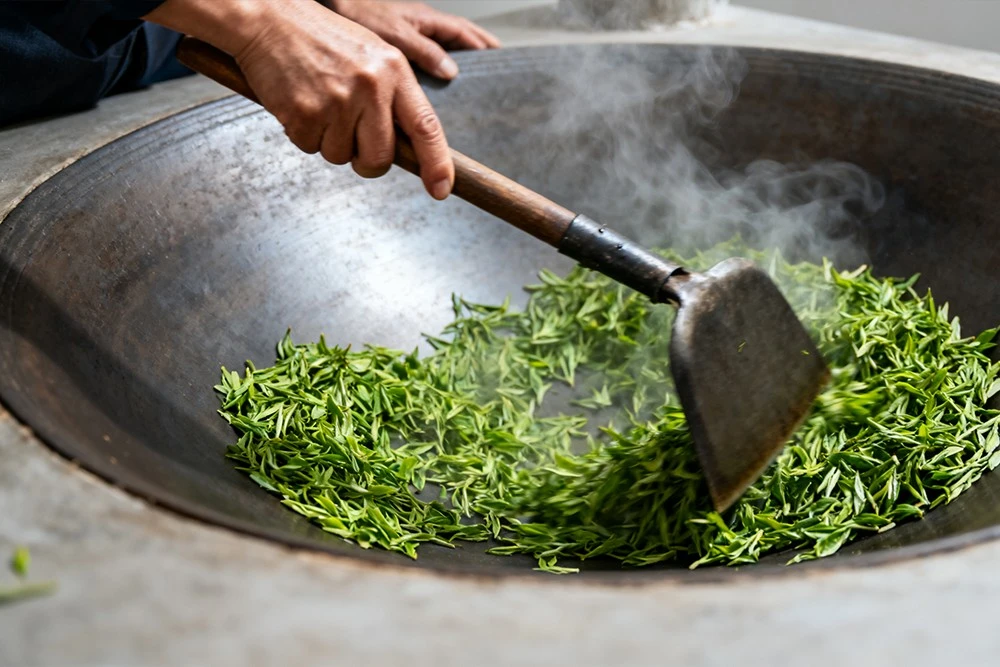DL-6CYMJ-32 Electric Black Gold Stone Matcha Grinder: grinds to ≤15μm, capacity ~50g/h, 0.55KW. Ideal for premium, small-batch fine matcha.
DL-6CSTL-CM50 for processing Green/Oolong tea, use wood, coal or pellet fuel heating, drum diameter 50cm, length 260cm, speed and temperature adjustable. Capacitu about 50 kg per hour.
DL-6CSTP-D110 for processing Green/Oolong tea, use wood, coal or pellet fuel heating, drum diameter 110cm, length 100cm, speed and temperature adjustable. Capacitu about 100 kg per hour.
DL-6CSTL-Q80 for processing Green/Oolong tea, use wood, coal or pellet fuel heating, drum diameter 80cm, length 400cm, speed and temperature adjustable. Capacitu about 150 kg per hour.
DL-6CFX-435 can used for all kind tea, through the volume of air blowing, different weight tea are blown to different positions and screened out through the corresponding outlet, 5 different sizes of tea can be selected.
DL-6CFX-F30-3QB is a new type of tea screening equipment developed by our company, It can separate fresh leaves and finished tea in one machine. It can save money and workers. It can adjust the speed of screening and wind speed. It is a necessary good helper for tea factory!
DL-6CYQT-6105 mainly used for Oolong tea processing, drum made of bamboo, the activity of withered tea was increased by shaking, It can make tea taste more fragrant, Capacity about 32 kg per batch.
This machine is suitable for the shaping and roasting process of high-grade curly tea. Tea roasted by this machine features tight and neat strips, uniform curling, bright green color, visible white fuzz, and rich aroma—fully demonstrating the characteristics of high-quality tea. The machine's heating system offers two options: electric heating and liquefied gas heating, allowing users to choose flexibly based on their actual needs.
If you’ve ever wondered why some green teas taste bright and grassy while others feel rich and toasty, the answer often lies in one critical processing step: fixation (known as shaqing in Chinese). Fixation uses heat to stop the enzyme polyphenol oxidase—the same enzyme that turns cut apples brown—from breaking down the tea’s natural compounds. But here’s the game-changer: the length of this heat treatment (fixation time) directly dictates the final quality of your green tea. Let’s break down its effects and share actionable parameters to get it right.
What Does Fixation Time Actually Control?
Fixation time is the window during which fresh tea leaves are exposed to high heat (usually 120–180°C/248–356°F). Too short, and enzymes aren’t fully deactivated; too long, and precious flavors and nutrients burn off. Here’s how different timeframes impact key quality traits:

1. Short Fixation Time (1–2 Minutes): For Delicate, Fresh Profiles
Short fixation prioritizes preserving the tea’s natural "green" character.
Best for: Delicate green teas like Longjing (Dragon Well) or Biluochun, where freshness is the star.
2. Long Fixation Time (3–5 Minutes): For Rich, Smooth Profiles
Longer fixation softens the tea’s edge and deepens its character by breaking down compounds and developing roasted notes.
Best for: Heartier green teas like Liu’an Guapian (Melon Seed Tea) or some Gunpowder green teas, where richness is preferred.
Key Factors That Change "Ideal" Fixation Time
There’s no one-size-fits-all number—these variables shift the sweet spot:
Green Tea Fixation Time Control Parameter Table
| Tea Variety | Fresh Leaf Grade | Fixation Method | Optimal Fixation Time | Key Control Indicators | Expected Quality Traits |
| Longjing (Dragon Well) | 1 bud + 1 leaf | Pan-frying | 2–3 mins | Leaf temperature: 150–160°C; Moisture loss: 15–20% | Bright green liquor; Grassy-sweet flavor |
| Biluochun | 1 bud + 1 leaf | Drum fixation | 1.5–2.5 mins | Leaf temperature: 140–150°C; Moisture loss: 12–18% | Floral aroma; Pale green color |
| Liu’an Guapian | 1 bud + 2 leaves | Pan-frying | 2.5–3.5 mins | Leaf temperature: 160–170°C; Moisture loss: 18–25% | Nutty flavor; Darker green liquor |
| Yunnan Green Tea | 1 bud + 3 leaves | Drum fixation | 3–4 mins | Leaf temperature: 150–160°C; Moisture loss: 20–28% | Smooth mouthfeel; Olive-green leaves |
It is recommended to use the tea hand roasting pot mentioned in the article for the fixing and stir-frying process.
Final Tip for Perfect Fixation
Whether you’re a home brewer testing small batches or a hobbyist learning processing: watch the leaves, not just the clock. When leaves turn bright green, lose their "raw" grass smell, and become slightly soft (but not crispy), they’re done. Over time, you’ll learn to match time to your desired flavor—because great green tea is as much art as science!